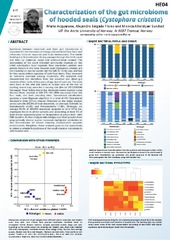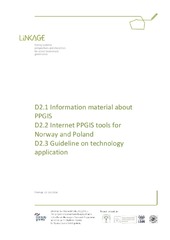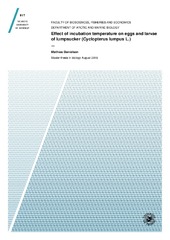Institutt for arktisk og marin biologi: Nye registreringer
Viser treff 1601-1620 av 2078
-
On the developmental and environmental regulation of secondary metabolism in Vaccinium spp. berries
(Journal article; Tidsskriftartikkel; Peer reviewed, 2016-05-18)Secondary metabolites have important defense and signaling roles, and they contribute to the overall quality of developing and ripening fruits. Blueberries, bilberries, cranberries, and other Vaccinium berries are fleshy berry fruits recognized for the high levels of bioactive compounds, especially anthocyanin pigments. Besides anthocyanins and other products of the phenylpropanoid and flavonoid ... -
Molecular Cloning and Expression Analysis of hyp-1 Type PR-10 Family Genes in Hypericum perforatum
(Journal article; Tidsskriftartikkel; Peer reviewed, 2016-04-21)Hypericum perforatum L. is an important medicinal plant for the treatment of depression. The plant contains bioactive hypericins that accumulate in dark glands present especially in reproductive parts of the plant. In this study, pathogenesis-related class 10 (PR-10) family genes were identified in H. perforatum, including three previously unidentified members with sequence homology to hyp-1, a ... -
Geographical area and life history traits influence diet in an Arctic marine predator
(Journal article; Tidsskriftartikkel; Peer reviewed, 2016-05-19)Global changes are thought to affect most Arctic species, yet some populations are more at risk. Today, the Barents Sea ecoregion is suffering the strongest sea ice retreat ever measured; and these changes are suspected to modify food access and thus diet of several species. Biochemical diet tracers enable investigation of diet in species such as polar bears (Ursus maritimus). We examined ... -
The Map of Sea Turtle Rescue Centres in the Mediterranean
(Conference object; Konferansebidrag, 2016-09-12) -
Characterization of the gut microbiome of hooded seals (Cystophora cristata)
(Conference object; Konferansebidrag, 2016-03-14) -
Global changes in local ecosystem services in Alpine and Arctic regions in Europe (introduction)
(Conference object; Konferansebidrag, 2016-09-19) -
Good-bye to tropical alpine plant giants under warmer climates? Loss of range and genetic diversity in Lobelia rhynchopetalum
(Journal article; Tidsskriftartikkel; Peer reviewed, 2016-11-25)The main aim of this paper is to address consequences of climate warming on loss of habitat and genetic diversity in the enigmatic tropical alpine giant rosette plants using the Ethiopian endemic Lobelia rhynchopetalum as a model. We modeled the habitat suitability of L. rhynchopetalum and assessed how its range is affected under two climate models and four emission scenarios. We used three ... -
A probabilistic algorithm to process geolocation data
(Journal article; Tidsskriftartikkel; Peer reviewed, 2016-11-18)<p><i>Background: </i>The use of light level loggers (geolocators) to understand movements and distributions in terrestrial and marine vertebrates, particularly during the non-breeding period, has increased dramatically in recent years. However, inferring positions from light data is not straightforward, often relies on assumptions that are difficult to test, or includes an element of subjectivity ... -
Using Ordinary Digital Cameras in Place of Near-Infrared Sensors to Derive Vegetation Indices for Phenology Studies of High Arctic Vegetation
(Journal article; Tidsskriftartikkel; Peer reviewed, 2016)To remotely monitor vegetation at temporal and spatial resolutions unobtainable with satellite-based systems, near remote sensing systems must be employed. To this extent we used Normalized Difference Vegetation Index NDVI sensors and normal digital cameras to monitor the greenness of six different but common and widespread High Arctic plant species/groups (graminoid/Salix polaris; Cassiope tetragona; ... -
Seasonal vertical strategies in a high-Arctic coastal zooplankton community
(Journal article; Tidsskriftartikkel; Peer reviewed, 2016-08-18)We studied the larger (>1000 µm) size fraction of zooplankton in an Arctic coastal water community in Billefjorden, Svalbard (78°40’ N), Norway, in order to describe seasonal vertical distributions of the dominant taxa in relation to environmental variability. Calanus spp. numerically dominated the herbivores; Aglantha digitale, Mertensia ovum, Beroë cucumis, and Parasagitta elegans were the ... -
Development and evaluation of internet-based PPGIS
(Research report; Forskningsrapport, 2014-10-15) -
Effect of incubation temperature on eggs and larvae of lumpsucker (Cyclopterus lumpus L.)
(Master thesis; Mastergradsoppgave, 2016-08-22)In this study the aim was to investigate how incubation temperature effected lumpsucker eggs and larvae; by comparing early cell symmetry, egg/embryo development, mortality, hatching success and early larvae size weight and histomorphology. Two batches of eggs were incubated at 3 temperature regimes; 1- Ambient seawater 4-6°C (cold), 2-Ambient seawater for 10 days then gradually increased to ... -
Core body temperature cycles in captive Svalbard rock ptarmigan (Lagopus muta hyperborea)
(Master thesis; Mastergradsoppgave, 2016-08-15)The Svalbard rock ptarmigan (Lagopus muta hyperborea) is an arctic animal and lives as such in constant light and constant darkness for parts of the year. They are therefore an interesting subject for chronobiologists and have been thoroughly studied in terms of their biological rhythms. One rhythmic physiological factor, however, has received little attention in former studies: oscillation in core ... -
Sampling strategies, distribution and concentration of planktonic salmon lice copepods in the Outer Hardangerfjord and the Altafjord
(Master thesis; Mastergradsoppgave, 2016-08-15)Salmon lice are parasitic copepods with three planktonic larvae stages, consisting of two nauplii stages and a copepodite stage. The parasite spread during these stages as plankton, and with the increased number of host represented by salmonid fish in aquaculture it is important to know the concentrations and ecology of the fee-living stages. Both Lepeophtheirus salmonis and Caligus elongatus are ... -
The effect of seasonality on polar cod (Boreogadus saida) dietary habits and temporal feeding strategies in Svalbard waters
(Master thesis; Mastergradsoppgave, 2016-05-29)Climate change in polar regions will likely disrupt the fine-tuned trophic interactions among organisms in Arctic marine ecosystems. Modifications in prey phenology and composition as well as increased competition and predation from boreal species expanding their range northward are expected to affect the key Arctic fish species polar cod (Boreogadus saida) and thus have important repercussions on ... -
Effects of chronic dietary petroleum exposure on reproductive development in polar cod (Boreogadus saida)
(Journal article; Tidsskriftartikkel; Peer reviewed, 2016-10-04)Increasing human activities in the Arctic raise the risk of petroleum pollution, thus posing an elevated risk for Arctic organisms to be chronically exposed to petroleum compounds. The endocrine disrupting properties of some of these compounds (i.e. polycyclic aromatic hydrocarbons [PAHs]) present in crude oil may have negative effects on the long and energy intensive reproductive development of ... -
An empirical evaluation of spatial value transfer methods for identifying cultural ecosystem services
(Journal article; Tidsskriftartikkel; Peer reviewed, 2016-04-09)A significant barrier to the assessment of ecosystem services is a lack of primary data, especially for cultural ecosystem services. Spatial value transfer, also known as benefits transfer, is a method to identify the probable locations of ecosystem services based on empirical spatial associations found in other geographic locations. To date, there has been no systematic evaluation of spatial value ... -
Rumen and Cecum Microbiomes in Reindeer (Rangifer tarandus tarandus) Are Changed in Response to a Lichen Diet and May Affect Enteric Methane Emissions
(Journal article; Tidsskriftartikkel; Peer reviewed, 2016-05-09)Reindeer (Rangifer tarandus tarandus) are large Holarctic herbivores whose heterogeneous diet has led to the development of a unique gastrointestinal microbiota, essential for the digestion of arctic flora, which may include a large proportion of lichens during winter. Lichens are rich in plant secondary metabolites, which may affect members of the gut microbial consortium, such as the methane-producing ... -
Autumn staging behaviour in Pink-footed Geese; a similar contribution among sexes in parental care
(Master thesis; Mastergradsoppgave, 2016-05-17)Geese are social birds and form pairs that can last a lifetime, being together throughout the year. Forming pairs and maintaining family groups increase the individual’s social status, giving it easier access to resources and more time to exploit them. Hence, social behaviour is favourable when pairs are building up body reserves before migrating to the breeding grounds as well as after breeding, ... -
Mitogenomic characterization and phylogenetic position of the oldest living vertebrate species - the Greenland shark (Somniosus microcephalus)
(Master thesis; Mastergradsoppgave, 2016-07-10)The Greenland shark (Squaliformes, Somniosus microcephalus) is the largest fish living in Arctic waters, but little is known about its biology. This species lives for at least 272 years and is listed as a near threatened species on the IUCN´s Red list of Threatened Species. As S. microcephalus is the oldest living vertebrate species, it is important to strive for its conservation. The aim of the ...


 English
English norsk
norsk


















